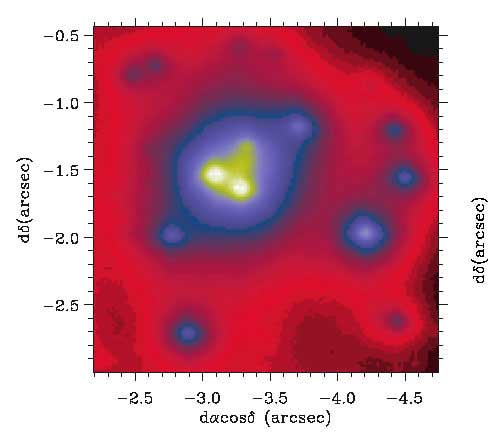A black hole with a mass of 1,300 solar masses surrounds the main black hole of the Milky Way - which has a mass of 4 million solar masses
Avi Blizovsky

Direct link to this page: https://www.hayadan.org.il/secondbg071104.html
A group of French and American astronomers, led by Jean-Pierre Millard of the Institute of Astrophysics of Paris, who used data from an optical telescope located in the northern Gemini telescope, confirmed the physical existence of a massive star cluster in the infrared source IRS 13E located near the center of the Milky Way galaxy.
The team also used data from the Hubble Space Telescope, the Chandra X-ray Observatory, the Canadian-French Observatory in Hawaii (CFHT) and the Very Large Array to provide as broad a spectral coverage as possible and complement the Gemini data. The Gemini observations confirmed the existence of two previously undiscovered foci within IRS 13E. A total of seven separate massive stars emerged within a once-larger cluster centered on a black hole about 1,300 solar masses in size. This black hole is separated from the black hole in the center of the galaxies that dissolved about 4 million solar masses). The seven individual stars in IRS 13E are within a range of about half a minute of arc, which at their distance from us means about 0.6 light years, and they are moving together westward at a similar speed of 280 kilometers per second.
The compactness of the cluster and the joint motion of its constituent stars lead scientists to estimate that the stars are held together by a massive source, the stellar black hole at the center of IRS 13E. The size of the cluster makes it possible to estimate the central bone radius. The radial velocity (plus or minus 30 kilometers per second) of the individual stars, derived from the measurements can be used to estimate the average orbital speed. The authors also investigated a variety of estimates and were able to estimate the black hole's mass at about 1,300 solar masses.
The team also estimates that the cluster was once distant from the center of the galaxy, and its stars formed away from the gravitational influence of the supermassive black hole at the center of the galaxy. It is possible that IRS 13E is what remains of the core of a much larger star cluster now spiraling towards Sgr A* – the location of the black hole at the center of the Milky Way.
This theory also explains the existence of other massive stars around the center of the galaxy, which appear to be stars torn from the cluster due to the gravitational environment near the black hole at the center of the galaxy.
The Gemini data were captured by a team led by François Rigaut of the Gemini Observatory, as part of an adaptive optics demonstration in July 2000. The results of the study were published in Astronomy and Astrophysics.
Know astrophysics 2 - stars and galaxies
For the news in Universe Today
https://www.hayadan.org.il/BuildaGate4/general2/data_card.php?Cat=~~~997394154~~~202&SiteName=hayadan
